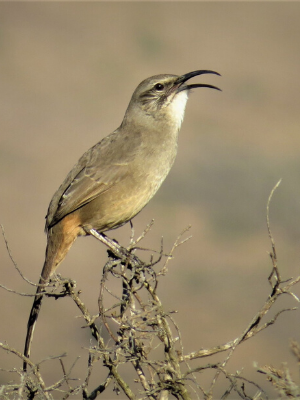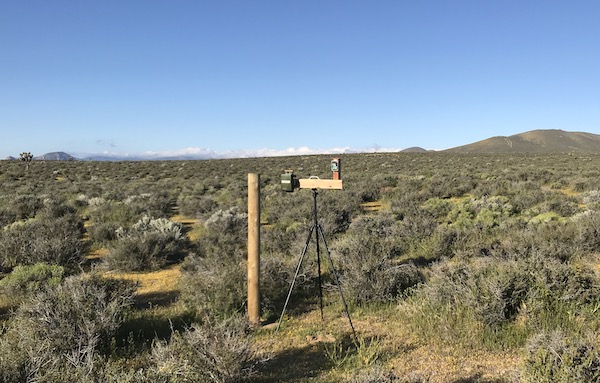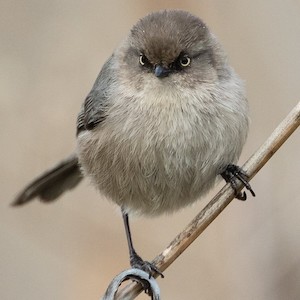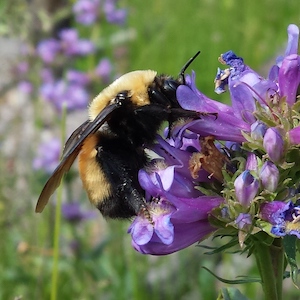The COVID-19 pandemic has changed the way many of us do our jobs, whether we're now working from home, or wearing masks and gloves in the workplace. IBP is no exception. Our staff are working from their kitchen tables or home offices, many of them busy reconfiguring plans for the upcoming fieldwork season.

California Thrashers are one of the species recorded in these parks. Photo by Maggie Smith.
Outdoor work monitoring birds might seem like a safe, socially distant activity. Away from the crowds, in the fresh air, just you and your binoculars–sounds ideal right? For the most part, the work itself might be a safe activity in the time of COVID-19, but the logistics underlying that fieldwork can be a different story. Field crews typically consist of workers who have travelled in from different regions of the US, who then live in group housing and carpool to their field sites–all of which contradict the public health recommendations we need to follow to reduce the spread of coronavirus. In addition, many of the lands that we work on are currently closed to the public.
So IBP staff are getting creative and flexible; where possible, we are finding ways to continue our research while ensuring the health and safety of our employees and volunteers. One research study that will be going forward this season takes advantage of some relatively new technology called Autonomous Recording Units (ARUs) to help monitor birds in California's State Vehicle Recreation Areas (SVRAs.)
This is part of an ongoing project in partnership with the National Audubon Society and California State Parks. A recent paper by IBP biologist Jerry Cole and Dr. Nicole Michel of Audubon, along with IBP's Rodney Siegel and CA State Parks' Nicolas Somilleda, reported some initial and surprising results from the project. Against expectations, some species of birds in the Hollister Hills SVRA appeared to be relatively unaffected by OHV use. A few species even seemed to be more abundant in areas with more OHV trails. But this is a single study of one, well-managed park and the study was primarily intended to demonstrate that the method used to analyze this type of data was appropriate. More research needs to be done. Bird population monitoring will continue across the parks, but not in the usual way.
Usually birds in these parks are monitored with traditional point counts. A trained observer stands in one place for a fixed amount of time and records all the birds they hear and see, though birds heard typically make up the bulk of observations. Since most of the SVRAs do not have local staff that are trained in bird identification, this year the parks hired IBP to conduct the surveys. But with coronavirus and the resulting stay at home orders, bringing in outside birders is no longer safe or feasible.

The two ARU models are mounted side by side on a tripod (collapsed in case in photo) so that their recordings can be compared.
ARUs may provide a solution. They are weather resistant recording devices that can be programmed to record for a desired amount of time. A skilled human later listens to the recording and records the birds they hear, "kind of like a blindfolded point count," says project leader Jerry Cole. Prior to the pandemic, IBP had done a pilot study in 2018 at Carnegie SVRA near Livermore, CA to see if ARUs would be an effective bird monitoring tool for these parks. Cole conducted point counts while the ARUs recorded alongside him. The traditional point count data was then compared to the data collected by the Cole listening to the ARU recordings.
The top of the line ARU model we used in 2018 worked well, but it was pricey–over $800. The pilot study this season is comparing the effectiveness of an economical ARU, that costs only about $50, to the pricey one. If the inexpensive models work just as well, they may be a good choice for fulfilling SVRA bird monitoring needs. But a rigorous side by side comparison of the two models is needed to ensure that the $50 ARU can provide good quality recordings.
This study is safe to do in light of COVID-19 restrictions because setting up the ARUs and programming them to record is a one-person job that can be done by a local park staffer, regardless of their skill at bird identification. The units will then be shipped back to IBP, where staff biologists will listen to the recordings and annotate the audible bird sounds. Cole will then run a statistical analysis to compare the data collected from each model.
ARUs have a lot of potential to collect important data about birds and other wildlife says Cole. "The potential of ARUs – not just audio recorders, but also radio receivers, cameras, and other tech– is pretty great because we now have relatively inexpensive storage and processing capabilities hosted in the cloud. When you have lots of digital eyes and ears you start to learn things you never would have known from a few trips to the field."
But lots of ears lead to lots of recordings, sometimes more than may be feasible for a human to listen to and process in a timely manner. That's where machine learning comes in. Cole says the recordings from this study will also be analyzed using an algorithm called BirdNET that was developed by the Cornell Lab of Ornithology and Chemnitz University of Technology. "BirdNET breaks a survey recording into 5 second clips and identifies any bird species recorded, outputs a text file with species name, time when detected, and confidence in that identification," says Cole. "We can compare this information with human annotation and determine how often BirdNET gets things right, and how often it misses species. We can also use BirdNET to help determine if we get better results from a particular ARU model."
Autonomous recording and machine learning certainly seem to remove the human element from fieldwork. Instead of listening to birds with the breeze in your hair, you–or your computer–is listening to recordings at your desk. Which frankly seems a little sad. Asked if he thinks this technology could replace traditional fieldwork, Cole answers with a confident no. "I think it’s fortunate that there are still some aspects of ecology that require a person out in the field. Even if ARUs were capable of collecting all ecological data, there is no doubt in my mind that an ecologist or field biologist needs to take a stroll through their study area to understand how all the organisms in that system interact." At the very least, you need a human brain to identify the important questions to ask.
Nevertheless, ARUs are one tool that IBP is using to continue our research during the COVID-19 pandemic. They won't be useful in all situations, but they are a start. Navigating this field season won't be easy, but we can put two of our well-honed field biology skills to use: attention to safety and the ability solve unexpected problems creatively.






